
Friday, January 14, 2011
Thursday, January 13, 2011
St. Francis of Assisi
Lord, make me an instrument of your peace.
Where there is hatred, let me sow love.
Where there is injury, pardon.
Where there is doubt, faith.
Where there is despair, hope.
Where there is darkness, light.
Where there is sadness, joy.
Where there is hatred, let me sow love.
Where there is injury, pardon.
Where there is doubt, faith.
Where there is despair, hope.
Where there is darkness, light.
Where there is sadness, joy.
Lao Tzu
"Be Content with what you have; rejoice in the way things are. When you realize there is nothing lacking, the whole world belongs to you."
~Lao Tzu
Reader
"There is no coming to consciousness without pain. People will do anything, no matter how absurd, in order to avoid facing their own soul. One does not become enlightened by imagining figures of light, but by making the darkness conscious."
~ Carl Jung
Rabindranath Tagore
"Faith is the bird that feels the light and sings when the dawn is still dark."
— Rabindranath Tagore
Poem by John Keats, 1838
Bright Star
Bright star, would I were steadfast as thou art —
Not in lone splendour hung aloft the night
And watching, with eternal lids apart,
Like Nature's patient, sleepless Eremite,
The moving waters at their priestlike task
Of pure ablution round earth's human shores,
Or gazing on the new soft-fallen mask
Of snow upon the mountains and the moors —
No — yet still stedfast, still unchangeable,
Pillow'd upon my fair love's ripening breast,
To feel for ever its soft swell and fall,
Awake for ever in a sweet unrest,
Still, still to hear her tender-taken breath,
And so live ever — or else swoon to death.
Bright star, would I were steadfast as thou art —
Not in lone splendour hung aloft the night
And watching, with eternal lids apart,
Like Nature's patient, sleepless Eremite,
The moving waters at their priestlike task
Of pure ablution round earth's human shores,
Or gazing on the new soft-fallen mask
Of snow upon the mountains and the moors —
No — yet still stedfast, still unchangeable,
Pillow'd upon my fair love's ripening breast,
To feel for ever its soft swell and fall,
Awake for ever in a sweet unrest,
Still, still to hear her tender-taken breath,
And so live ever — or else swoon to death.
It is unclear when Keats first drafted Bright Star, his biographers suggest different dates. Motion suggests it was begun in October 1819. [1]Gittings states it was begun in April 1818 - before he met his beloved Fanny Brawne and then revised it for her. [2] Colvin believed it to have been in the last week of February 1819, immediately after their informal engagement.
The poem came to be forever associated with the "Bright Star" Fanny Brawne - with whom Keats became infatuated. Gittings says, it was given as "a declaration of his love". [5]
It was officially published in 1838, in The Plymouth and Devonport Weekly Journal, 17 years after Keats death.
Heinrich Zille
Addressed to a star (perhaps Polaris, around which the heavens appear to wheel), the sonnet expresses the poet's wish to be as constant as the star while he presses against his sleeping love. The use of the star imagery is unusual in that Keats dismisses many of its more apparent qualities, focusing on the star's steadfast and passively watchful nature. In the first recorded draft (copied by Charles Brown and dated to early 1819), the poet loves unto death; by the final version, death is an alternative to love.
The poem is punctuated as a single sentence and uses the rhyme form of the Shakespearean sonnet (ababcdcdefefgg) with the customary volta, or turn in the train of thought, delayed on this occasion until the ultimate line of the final heroic couplet.
Subscribe to:
Comments (Atom)






